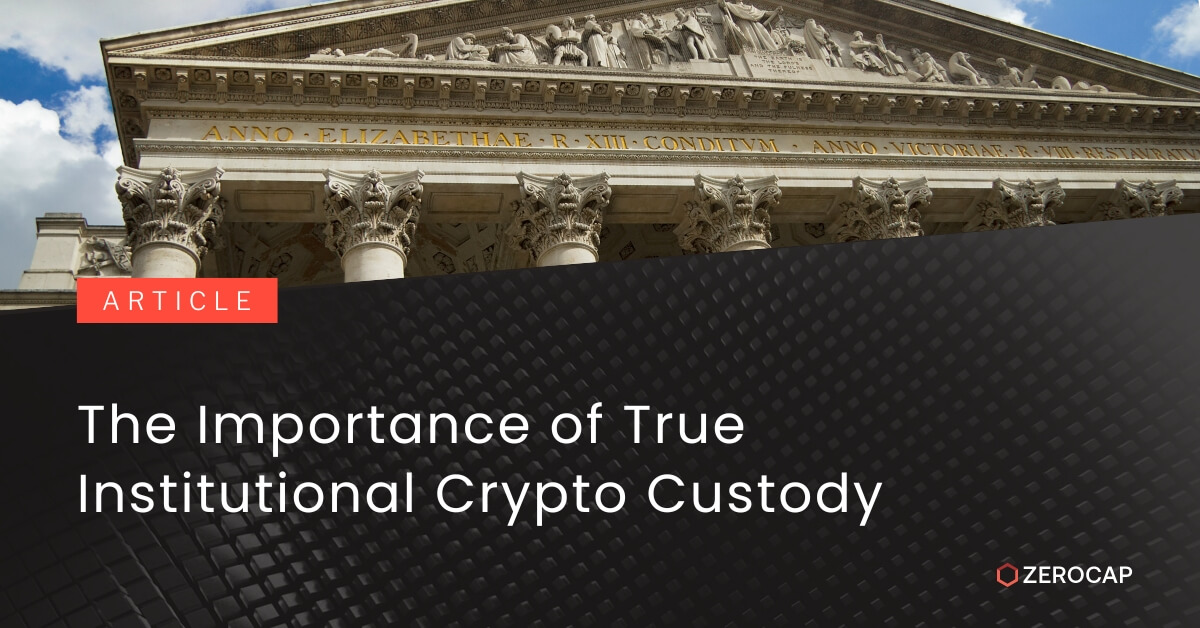Content
- The Components of True Institutional Crypto Custody
- Effective Hardware
- Cryptographic Security
- Governance Controls
- Institutional Counterparties
- Transparency and Segregation of Funds
- Why True Institutional Crypto Custody is Needed
- Conclusion
- About Zerocap
- FAQs
- What are the components of true institutional crypto custody?
- Why is effective hardware crucial for institutional crypto custody?
- What role does cryptographic security play in institutional crypto custody?
- How do governance controls contribute to institutional crypto custody?
- Why is true institutional crypto custody needed in the cryptocurrency space?
17 Jan, 23
The Importance of True Institutional Crypto Custody

- The Components of True Institutional Crypto Custody
- Effective Hardware
- Cryptographic Security
- Governance Controls
- Institutional Counterparties
- Transparency and Segregation of Funds
- Why True Institutional Crypto Custody is Needed
- Conclusion
- About Zerocap
- FAQs
- What are the components of true institutional crypto custody?
- Why is effective hardware crucial for institutional crypto custody?
- What role does cryptographic security play in institutional crypto custody?
- How do governance controls contribute to institutional crypto custody?
- Why is true institutional crypto custody needed in the cryptocurrency space?
The cryptocurrency space has been plagued by a lack of true institutional crypto custody solutions, resulting in widespread fear of losing digital assets. Nonetheless, participants have emerged that offer effective custody solutions that enable the exploration of more use cases and innovation at the blockchain level. This article will delve into the different components of this tier of crypto custody and the need for it in the web3 space.

The Components of True Institutional Crypto Custody
True institutional custody is made up of a number of different layers, each working together to mitigate the existence of deleterious attack vectors. The overall aim of these layers is to provide a hermetically sealed custody solution to safeguard digital assets at a quality above air-gapped computers in a single physical location. In the blockchain industry, institutional-grade crypto custody carries significant importance given the fact that transactions cannot be reversed as they can in the traditional banking world; accordingly, the finality of hacks and exploits poses a severe issue.
Effective Hardware
The computer hardware used to secure and protect digital assets is a crucial aspect of true institutional crypto custody. Specialised devices like Hardware Security Modules (HSMs) can be used to store cryptographic secrets, including one’s private key. The security of an HSM depends on its design. The U.S. Federal Information Processing Standard (FIPS) provides security ratings for HSMs; modules with the most security prevent any entity, including authorised users, from extracting their cryptographic information. HSMs of this calibre can provide a high level of security for digital assets.
Cryptographic Security
Cryptographic security is another important component of institutional crypto custody. One way to ensure the security of cryptographic keys is through the use of sharding, which involves dividing the keys into smaller segments and distributing them among different devices or locations. This makes it much more difficult for an attacker to compromise the keys, as they would need to gain access to all of the segments in order to reconstruct the full key. Multi-party signature wallets allow multiple parties to sign transactions with their own private keys, providing an additional layer of security and accountability. Multi-party computation technology, on the other hand, enables multiple parties to perform calculations on sensitive data without revealing the data to one another, helping to protect the confidentiality of the data.
Governance Controls
The layer of effective governance controls helps to ensure the security and integrity of the custodial process. Such controls should include both human oversight and role separation measures, together creating a robust and secure system. The issuance of instructions and the governance controls around the movement of funds is just as important as the secure storage of keys.
In the realm of cryptocurrency custody, it is especially important to design the process of moving funds in a way that diffuses control among multiple parties. This helps to prevent any internal collusion from corrupting the custody solution. By implementing robust governance controls and separating responsibilities among different parties, true institutional custody solutions can provide a high level of security and accountability for digital assets.
Institutional Counterparties
Institutional counterparties provide the necessary infrastructure and support to safeguard digital assets. These counterparties may include banks, asset managers and other financial institutions with the resources and expertise to offer high-quality custodial services. Institutional counterparties typically have well-established processes and controls in place to ensure the security of digital assets, including strong risk management frameworks, advanced security technologies, and robust governance controls – as outlined above. They may additionally have insurance coverage and other protections to mitigate the risk of loss or theft. Counterparties can improve trust in their custody mechanism by regularly engaging in audits of their systems and controls as well as obtaining certifications like SOC 2.
By using institutional counterparties, crypto custody solutions can provide a level of security and protection that is on par with traditional financial institutions, helping to build trust and confidence in the cryptocurrency industry.
Transparency and Segregation of Funds
In the design of true institutional crypto custody services, transparency and the segregation of client funds play an important role in raising the security and integrity of the digital assets in custody. The transparency of the blockchain ensures that on the assumption tokens are held on-chain, clients receive visibility into the movements and balances of their funds. This can help to build trust and confidence among investors and users, as it allows for independent verification of the holdings and transactions.
Another important aspect is the segregation of client assets. This can be achieved through the use of on-chain wallets for each client, rather than pooling all of the assets together. This ensures that each client’s assets are clearly and distinctly separated, making it easier to track and manage them.
In addition to on-chain storage and segregation, institutional-grade crypto custody should also provide visibility into their custody services. This could include regular reporting and audits, as well as transparency into the processes and controls in place to safeguard digital assets. Offering transparency and segregation can help to build trust and confidence in the cryptocurrency industry.
Why True Institutional Crypto Custody is Needed
True institutional crypto custody allows for innovation to occur at the technical level, rather than developers constantly focusing on improving security. With a strong foundation of institutional-grade crypto custody in place, developers and companies can turn their attention to building new and innovative applications and use cases for blockchains, instead of facing the impasse of purely concentrating on the security of the underlying assets.
Furthermore, effective custody can help to increase adoption from institutions. Many institutions are hesitant to get involved in the cryptocurrency space due to concerns about the security of their funds. By providing a high level of security and protection, state-of-the-art crypto custody can help to reduce these fears and make it more appealing for institutions to enter the market. This can help to bring more institutional investment and stability to the industry.
Additionally, it aids in establishing standards for the custody of digital assets. By setting a high bar for security and transparency, a benchmark is created for other players in the industry to follow. This can help to build trust and confidence in the market, which is essential for the long-term growth and success of the cryptocurrency industry. It can also help to establish best practices and industry standards for the safekeeping of digital assets.
Conclusion
Safe custody is the cornerstone of a secure and successful cryptocurrency market. It is the foundation upon which the industry can grow and reach its full potential. By providing a high level of security and protection for digital assets, institutional crypto custody enables wider innovation, attracts investment, and establishes standards for the safe keeping of these assets. Institutional-grade security is essential for building trust among investors and users, and for the long-term growth of the blockchain industry.
About Zerocap
Zerocap provides digital asset investment and digital asset custodial services to forward-thinking investors and institutions globally. For frictionless access to digital assets with industry-leading security, contact our team at [email protected] or visit our website www.zerocap.com
This material is intended for illustrative purposes and general information only. It does not constitute financial advice nor does it take into account your investment objectives, financial situation or particular needs. You should consider the information in light of your objectives, financial situation and needs before making any decision about whether to acquire or dispose of any digital asset. Investments in digital assets can be risky and you may lose your investment. Past performance is no indication of future performance. Zerocap Pty Ltd carries out regulated and unregulated activities. Spot crypto-asset services and products offered by Zerocap are not regulated by ASIC. Zerocap Pty Ltd is registered with AUSTRAC as a DCE (digital currency exchange) service provider (DCE100635539-001). Regulated services and products include structured products (derivatives) and funds (managed investment schemes) are available to Wholesale Clients only as per Sections 761GA and 708(10) of the Corporations Act 2001 (Cth) (Sophisticated/Wholesale Client). To serve these products, Zerocap Pty Ltd is a Corporate Authorised Representative (CAR: 001289130) of AFSL 340799)
FAQs
What are the components of true institutional crypto custody?
True institutional crypto custody is composed of several layers, including effective hardware, cryptographic security, governance controls, institutional counterparties, and transparency and segregation of funds. These components work together to provide a secure custody solution that safeguards digital assets.
Why is effective hardware crucial for institutional crypto custody?
Effective hardware, such as Hardware Security Modules (HSMs), is crucial for securing and protecting digital assets. HSMs are used to store cryptographic secrets, including private keys. The security of an HSM depends on its design, with the highest security modules preventing any entity, including authorised users, from extracting their cryptographic information.
What role does cryptographic security play in institutional crypto custody?
Cryptographic security ensures the security of cryptographic keys. Techniques such as sharding, which involves dividing the keys into smaller segments and distributing them among different devices or locations, make it more difficult for an attacker to compromise the keys. Multi-party signature wallets and multi-party computation technology also contribute to cryptographic security.
How do governance controls contribute to institutional crypto custody?
Governance controls, including human oversight and role separation measures, ensure the security and integrity of the custodial process. The process of moving funds should be designed in a way that diffuses control among multiple parties to prevent internal collusion from corrupting the custody solution.
Why is true institutional crypto custody needed in the cryptocurrency space?
True institutional crypto custody allows for innovation at the technical level, increases adoption from institutions, and aids in establishing standards for the custody of digital assets. With a strong foundation of institutional-grade crypto custody in place, developers can focus on building new applications and use cases for blockchains. It also helps to increase trust among investors and users, which is essential for the long-term growth and success of the cryptocurrency industry.
Like this article? Share
Latest Insights
Interview with Ausbiz: How Trump’s Potential Presidency Could Shape the Crypto Market
Read more in a recent interview with Jon de Wet, CIO of Zerocap, on Ausbiz TV. 23 July 2024: The crypto market has always been
Weekly Crypto Market Wrap, 22nd July 2024
Download the PDF Zerocap is a market-leading digital asset firm, providing trading, liquidity and custody to forward-thinking institutions and investors globally. To learn more, contact
What are Crypto OTC Desks and Why Should I Use One?
Cryptocurrencies have gained massive popularity over the past decade, attracting individual and institutional investors, leading to the emergence of various trading platforms and services, including
Receive Our Insights
Subscribe to receive our publications in newsletter format — the best way to stay informed about crypto asset market trends and topics.



 Share
Share  Tweet
Tweet  Post
Post 